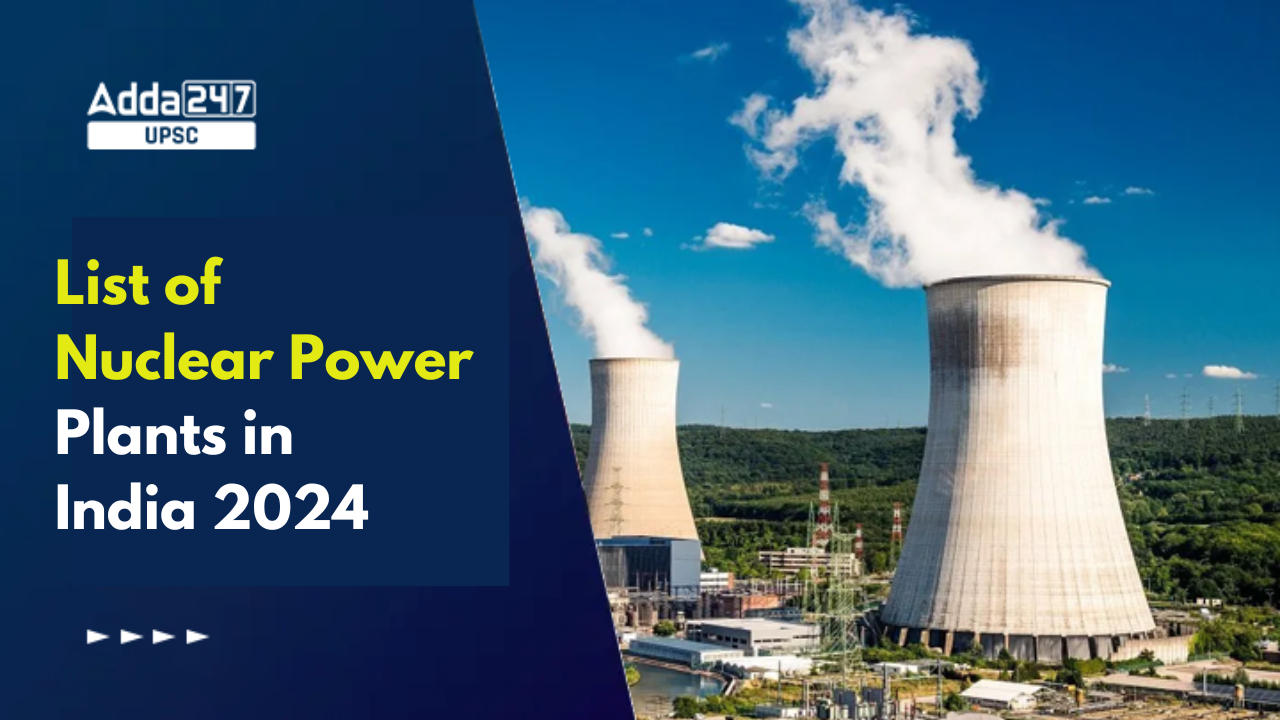Table of Contents
Nuclear Power Plants serve as a vital energy source in India’s energy landscape. Knowledge of the list of nuclear power plants in India is essential for various government exams like those conducted by Banks, SSCs, State PSCs, and the prestigious UPSC Prelims Exam 2024. Understanding these power plants is crucial for a comprehensive grasp of India’s energy sector and current affairs. This article presents the complete list of Nuclear Power Plants in India for reference.
Nuclear Power Plant in India
India has been actively developing nuclear power since the 1950s to meet its growing energy needs. Nuclear power is the fifth-largest source of electricity in India, after coal, gas, hydroelectricity, and wind power. As of November 2020, India has 23 nuclear reactors in operation in 8 nuclear power plants, with a total installed capacity of 7,380 MW.
Nuclear power produced a total of 43 TWh in 2020–21, contributing 3.11% of total power generation in India (1,382 TWh). 10 more reactors are under construction with a combined generation capacity of 8,000 MW.
Nuclear Power Plants in India in News
The Union Minister Dr Jitendra Singh informed Rajya Sabha that 22 Nuclear Power Reactors are operational in the country.
- He also informed that while in the past India’s nuclear installations were mostly confined to the South Indian States or in the west in Maharashtra and Gujarat, the present government is also promoting its expansion to other parts of the country.
- In this context, he cited the example of the upcoming nuclear power plant in Gorakhpur town of Haryana which will become functional shortly.
Nuclear Power Plants in India 2024
India’s Nuclear Power capacity experienced a significant increase after 2014, coinciding with Narendra Modi assuming office as the Prime Minister.
- In the fiscal year 2013-14, the annual nuclear power generation reached 35,333 Million Units, while in the most recent year of 2021-22, it reached 47,112 Million Units. This represents a nearly 30 to 40 per cent increase in just over eight and a half years.
- Under the leadership of Prime Minister Modi, the Union Cabinet also granted simultaneous bulk approval for 11 indigenous pressurized heavy water reactors in 2017. These reactors come at a total cost of Rs. 1,05,000 crore and boast a combined capacity of 7,000 Mega Watts.
List of Nuclear Power Plants in India
Nuclear Power ranks as the fifth-largest electricity generation source in India, following coal, gas, wind power, and hydroelectricity. The country boasts Asia’s first nuclear reactor, the Apsara Research Reactor located in Mumbai. Presently, India operates 22 nuclear reactors, consisting of 18 Pressurised Heavy Water Reactors (PHWRs) and 4 Light Water Reactors (LWRs).
Below is the list of 7 sites where Nuclear Power Plants are located in India. Candidates can access the PDF of the List of Nuclear Power Plants in India provided at both the top and bottom of this article.
| List of Operational Nuclear Power Plants in India | |||
| Name Of Nuclear Power Station | Location | Operator | Capacity |
| Kakrapar Atomic Power Station – 1993 | Gujarat | NPCIL | 440 |
| (Kalpakkam) Madras Atomic Power Station – 1984 | Tamil Nadu | NPCIL | 440 |
| Narora Atomic Power Station- 1991 | Uttar Pradesh | NPCIL | 440 |
| Kaiga Nuclear Power Plant -2000 | Karnataka | NPCIL | 880 |
| Rajasthan Atomic Power Station – 1973 | Rajasthan | NPCIL | 1,180 |
| Tarapur Atomic Power Station – 1969 | Maharashtra | NPCIL | 1,400 |
| Kudankulam Nuclear Power Plant – 2013 | Tamil Nadu | NPCIL | 2,000 |
List of Nuclear Power Stations in India
The Nuclear Power Stations in India table highlights the list of Nuclear Power Stations in India that are under construction along with the capacity and operator.
| Under Construction Nuclear Power Plants in India List | |||
| Name Of Nuclear Power Station | Location | Operator | Capacity |
| Madras (Kalpakkam) | Tamil Nadu | BHAVINI | 500 |
| Rajasthan Unit 7 and 8 | Rajasthan | NPCIL | 1,400 |
| Kakrapar Unit 3 and 4 | Gujarat | NPCIL | 1,400 |
| Kudankulam Unit 3 and 4 | Tamil Nadu | NPCIL | 2,000 |
List of Planned Nuclear Power Plants in India
Below is the list of Upcoming Nuclear Power Plant in India. These Nuclear Power Plants are planned to be constructed in the near future. The below Nuclear Power Plants in India table list the nuclear power station’s name, their location, and their proposed capacity.
| Planned Nuclear Power Plants in India List | ||
| Name Of Nuclear Power Station | Location | Capacity |
| Tarapur | Maharashtra | 300 |
| Madras | Tamil Nadu | 1,200 |
| Kaiga | Karnataka | 1,400 |
| Chutka | Madhya Pradesh | 1,400 |
| Gorakhpur | Haryana | 2,800 |
| Bhimpur | Madhya Pradesh | 2,800 |
| Mahi Banswara | Rajasthan | 2,800 |
| Haripur | West Bengal | 4,000 |
| Mithi Virdi (Viradi) | Gujarat | 6,000 |
| Kovvada | Andhra Pradesh | 6,600 |
| Jaitapur | Maharashtra | 9,900 |
Also Read UPSC Indian Polity Notes



 TSPSC Group 1 Question Paper 2024, Downl...
TSPSC Group 1 Question Paper 2024, Downl...
 TSPSC Group 1 Answer key 2024 Out, Downl...
TSPSC Group 1 Answer key 2024 Out, Downl...
 UPSC Prelims 2024 Question Paper, Downlo...
UPSC Prelims 2024 Question Paper, Downlo...




